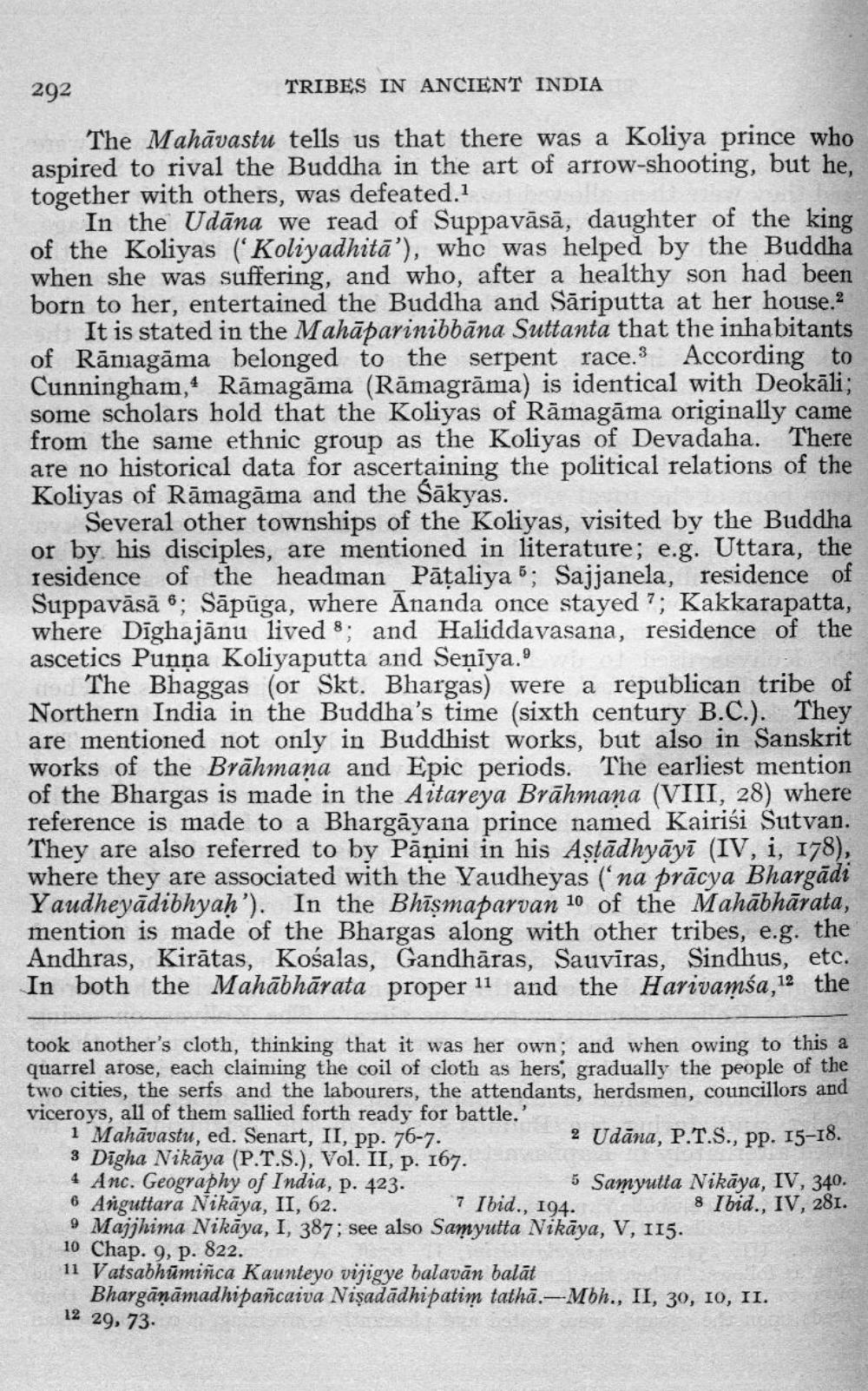________________
TRIBES IN ANCIENT INDIA
The Mahavastu tells us that there was a Koliya prince who aspired to rival the Buddha in the art of arrow-shooting, but he, together with others, was defeated.1
292
In the Udana we read of Suppavāsā, daughter of the king of the Koliyas (Koliyadhita'), who was helped by the Buddha when she was suffering, and who, after a healthy son had been born to her, entertained the Buddha and Sariputta at her house.2
It is stated in the Mahaparinibbana Suttanta that the inhabitants of Rāmagāma belonged to the serpent race.3 According to Cunningham, Rāmagāma (Ramagrāma) is identical with Deokāli; some scholars hold that the Koliyas of Ramagāma originally came from the same ethnic group as the Koliyas of Devadaha. There are no historical data for ascertaining the political relations of the Koliyas of Ramagāma and the Sakyas.
Several other townships of the Koliyas, visited by the Buddha or by his disciples, are mentioned in literature; e.g. Uttara, the residence of the headman Paṭaliya; Sajjanela, residence of Suppavāsā; Sāpūga, where Ananda once stayed 7; Kakkarapatta, where Dighajānu lived 8; and Haliddavasana, residence of the ascetics Punna Koliyaputta and Seniya."
od The Bhaggas (or Skt. Bhargas) were a republican tribe of Northern India in the Buddha's time (sixth century B.C.). They are mentioned not only in Buddhist works, but also in Sanskrit works of the Brahmana and Epic periods. The earliest mention of the Bhargas is made in the Aitareya Brahmana (VIII, 28) where reference is made to a Bhargayana prince named Kairisi Sutvan. They are also referred to by Panini in his Aṣṭadhyayi (IV, i, 178), where they are associated with the Yaudheyas (na pracya Bhargadi Yaudheyadibhyaḥ'). In the Bhismaparvan 10 of the Mahabharata, mention is made of the Bhargas along with other tribes, e.g. the Andhras, Kirātas, Kośalas, Gandhāras, Sauviras, Sindhus, etc. In both the Mahabharata proper 11 and the Harivamsa,12 the
took another's cloth, thinking that it was her own; and when owing to this a quarrel arose, each claiming the coil of cloth as hers, gradually the people of the two cities, the serfs and the labourers, the attendants, herdsmen, councillors and viceroys, all of them sallied forth ready for battle.
1 Mahāvastu, ed. Senart, II, pp. 76-7.
2 Udana, P.T.S., pp. 15-18.
3 Digha Nikaya (P.T.S.), Vol. II, p. 167. 4 Anc. Geography of India, p. 423.
6 Anguttara Nikaya, II, 62. 9 Majjhima Nikaya, I, 387; see also Samyutta Nikaya, V, 115. 10 Chap. 9, p. 822.
11 Vatsabhūminca Kaunteyo vijigye balavan balāt
Bharganamadhipañcaiva Nişadadhipatim tatha.-Mbh., II, 30, 10, II.
12 29, 73
5 Samyutta Nikaya, IV, 340. 7 Ibid., 194. 8 Ibid., IV, 281.




